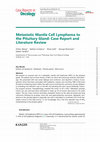Papers by George Kleinman

European Journal of Cardio-Thoracic Surgery, Dec 1, 2009
Objective: To shorten cooling/rewarming associated with hypothermic neuroprotection strategies du... more Objective: To shorten cooling/rewarming associated with hypothermic neuroprotection strategies during complex aortic arch surgery, selective cerebral perfusion (SCP) at 28 8C has recently been advocated, although its safe limits -especially with regard to the ischaemic tolerance of the spinal cord -have not been systematically examined. Methods: Twenty juvenile Yorkshire pigs (30.3 AE 2.8 kg) were randomly allocated to undergo circulatory arrest and SCP at 28 8C for 90 min (group A; N = 12) or 120 min (group B; N = 8) at 50 mmHg using alpha-stat pH management. Spinal cord blood flow (SCBF) was assessed using fluorescent microspheres at baseline (prior to SCP); at 5 and 80 min during SCP, and at 1, 5 and 48 h after cardiopulmonary bypass (CPB). A modified Tarlov score was used to evaluate neurobehavioural recovery in all survivors blindly from videotapes for 5 days postoperatively. Histological ischaemic spinal cord injury was scored after sacrifice. Results: All pigs could be weaned from CPB and ventilation, but seven pigs (58%) in group A and five (63%) in group B developed multi-organ failure and died within 24 h. SCBF diminished immediately after initiation of SCP and was absent throughout SCP in all segments below T8/9, recovering to baseline 1 h after SCP at all cord levels. All survivors suffered moderate-to-severe histological lumbar spinal cord damage, more severe in group B ( p 0.049). Three of five group A pigs recovered normal function, but two suffered paraparesis. Group B survivors had a worse neurologic outcome ( p < 0.0001): all suffered paraplegia (one immediate, and two on day 2, after initial recovery). Conclusion: SCP provides insufficient SCBF below T8/9 to sustain cord viability. At 28 8C, the ischaemic tolerance of the cord may be exceeded enough by 90 min to impair function; by 120 min, SCP at 28 8C invariably results in paraplegia.

American Journal of Clinical Pathology, 2018
Objectives: Current classification of squamous cell carcinoma precursors includes two distinct ca... more Objectives: Current classification of squamous cell carcinoma precursors includes two distinct categories: HPV-dependent low-grade or high-grade squamous intraepithelial lesions (LGSIL, HGSIL) and HPVindependent TP53-associated differentiated type VIN (dVIN). Distinguishing between these two is important because the risk of progression to invasion can be rapid in dVIN. Methods: A 64-year-old woman presented with a right vulvar lesion for presurgical consultation in our institution. Her previous biopsy at another hospital was diagnosed as dVIN based on the morphology, patchy p16 and weak p53 staining. Right vulvar excision and immunochemical analyses were performed. Results: Sections show areas of irregular elongation and anastomoses of the rete ridges, basal and parabasal keratinocytic atypia with terminal differentiation but with areas of abnormal keratinization. The overlying hyperkeratosis and a background of lichen sclerosus are present. Immunostains for p53, p16, and Ki67 were performed, which showed an unequivocal evidence of mostly parabasal nuclear p53 positivity, with elevated Ki67labeling index. The findings are highly suggestive of dVIN. However, a "block-type," strong and diffuse nuclear and cytoplasmic p16 positivity is present on p16 immunostain in the lesional cells. Molecular tests for high-risk HPV were performed and showed negative results for a selected panel. Although the treatment for both entities is wide local excision, the unique staining results on p53 and p16 in this vulvar lesion posed a challenge in the diagnosis. Conclusion: This is a rare case showing both typical immunochemical features for two distinct entities in vulvar precancerous lesions. This suggests (1) diffuse and strong with a "block-type" positivity of p16 is probably not sufficient to rule out dVIN; or (2) there is a possibility of unusual high-risk HPV infection associated with TP53 mutation in this patient. These two events might not be mutually exclusive of tumorigenesis of vulvar intraepithelial neoplasia.
American Journal of Clinical Pathology, 2018

Case Reports in Oncology, Jan 13, 2016
We present an unusual case of a metastatic mantle cell lymphoma (MCL) to the pituitary gland. The... more We present an unusual case of a metastatic mantle cell lymphoma (MCL) to the pituitary gland. The patient had a known history of MCL for which she previously received chemotherapy. She presented with new-onset diplopia and confusion, and reported a history of progressive vision blurriness associated with headache, nausea, and vomiting. MRI of the brain showed an enhancing lesion within the sella turcica involving the cavernous sinuses bilaterally, extending into Meckel's cave on the left, and abutting the optic nerves bilaterally. Following surgical excision, histopathology revealed the tumor to be a MCL. Metastatic pituitary tumors are rare and have been estimated to make up 1% of tumors discovered in the sellar region. The two most common secondary metastatic lesions to the sella are breast and lung carcinoma followed by prostate, renal cell, and gastrointestinal carcinoma. Metastatic lymphoma to the pituitary gland is especially rare and is estimated to constitute 0.5% of all metastatic tumors to the sella turcica. To our knowledge, this is the first reported case of MCL metastasizing to the pituitary gland.
Journal of Neurological Surgery Reports, Oct 29, 2015
Medical Mycology Case Reports

Respiratory Medicine Case Reports, 2021
We report a case of a 60-year-old man who underwent orthotopic heart transplantation after short-... more We report a case of a 60-year-old man who underwent orthotopic heart transplantation after short-term receipt of low-dose oral amiodarone for the management of ventricular tachycardia. Prior to transplant surgery, he had a normal chest radiograph and was free of supplemental oxygen. His initial postoperative chest radiograph showed subtle infiltrates, and thereafter his chest imaging continued to worsen. Although he was eventually able to wean off mechanical ventilation via a tracheostomy, he remained dyspneic and oxygen-dependent with persistently abnormal chest imaging as his post-transplant corticosteroid regimen was being tapered. In light of progressively worsening diffuse lung disease, he underwent bronchoscopy with transbronchial biopsies. Histology revealed foamy macrophages in association with foci of organizing pneumonia, a picture consistent with amiodarone pulmonary toxicity. Given these findings, corticosteroid dosing was increased for the clinical diagnosis of acute amiodarone pulmonary toxicity with subsequent normalization of oxygen saturation and chest radiography. Our case is the first to identify orthotopic heart transplantation as a potential trigger for acute amiodarone pulmonary toxicity. It is also only the second documented example of organizing pneumonia as the histological substrate of amiodarone pulmonary toxicity, which is an association that has therapeutic implications.

Cancer research, 1997
The deleted in colorectal cancer (DCC) gene, a candidate tumor suppressor gene on chromosome 18q2... more The deleted in colorectal cancer (DCC) gene, a candidate tumor suppressor gene on chromosome 18q21, encodes a neural cell adhesion molecule family protein that is most highly expressed in the nervous system. To address the hypothesis that DCC may play a role in glioma development and/or progression, we examined DCC expression by immunohistochemistry in 57 resected human astrocytic tumors. Overall, low-grade astrocytomas were predominantly DCC positive (15 of 16, or 94%), whereas high-grade tumors significantly less often expressed the DCC protein (27 of 41, or 66%; P = 0.03). We were able to directly assess the relationship between DCC expression and tumor progression in 15 patients who initially presented with a low-grade astrocytoma and subsequently recurred with a glioblastoma. Within this panel of paired lesions from the same patient, 14 of 15 (93%) low-grade tumors expressed the DCC protein, whereas only 7 of 15 (47%) corresponding glioblastomas were DCC positive. We also obser...

Journal of Neurosurgery, 1978
✓ The authors give follow-up information on Case 59 of Cushing's 1931 series of cerebellar as... more ✓ The authors give follow-up information on Case 59 of Cushing's 1931 series of cerebellar astrocytomas. The patient died with a malignant cerebellar astrocytoma 48 years after partial removal of a previously benign astrocytoma at the same site. Including the present one, there have been only five reported cases in which this has occurred. Ordinarily, juvenile pilocytic astrocytomas are of extremely benign character, and it is well established that even with incomplete resections patients have survived for years without progression of the tumor. Not all of the cases so reported can be wholly accepted as representing malignant transformation of the tumor, but may instead be instances of recurrence of an inherently benign glioma since the presence of features such as endothelial hyperplasia or nuclear atypicality in a juvenile pilocytic astrocytoma does not warrant its being classified as malignant. Features truly suggestive of malignancy are hypercellularity, frequent mitoses, ne...
Journal of Neuropathology and Experimental Neurology, 1985
Journal of Neuropathology and Experimental Neurology, 1979
Journal of Neuropathology and Experimental Neurology, 1980
Journal of Neuropathology and Experimental Neurology, 1980
The American Journal of Surgical Pathology, 1981
A 15-year-old girl had a hysterectomy for intractable vaginal bleeding. Examination of the specim... more A 15-year-old girl had a hysterectomy for intractable vaginal bleeding. Examination of the specimen revealed a polypoid tumor that filled the endometrial cavity; microscopical examination disclosed a low-grade fibrillary astrocytoma. Glial tissue in the uterus has been generally considered to arise from implantation of fetal tissue. A reliably negative coital history makes such an explanation unlikely in the present case in which the tissue appeared to be truly neoplastic and of either germ cell or mesodermal origin. The patient is free of disease 6 years later.
American Journal of Neuroradiology, May 1, 1982

Cancer Research
The mechanistic target of rapamycin (mTOR: aka mammalian target of rapamycin), a serine/threonine... more The mechanistic target of rapamycin (mTOR: aka mammalian target of rapamycin), a serine/threonine kinase, functions by forming two multiprotein complexes termed mTORC1 and mTORC2. Glioblastoma (GBM) is a malignant and lethal brain tumor that remains incurable partly due to the existence of untreatable cancer stem cells (CSC). The pathogenesis of GBM is largely due to the loss of the tumor suppressor gene PTEN, which is implicated in the aberrant activation of the mTOR pathway. The major cause of tumor recurrence, growth, and invasion is the presence of a unique population of CSC. Resistance to conventional therapies appears to be caused by both extensive genetic abnormalities and dysregulation of the transcription landscape. Consequently, CSCs have emerged as targets of interest in new treatment paradigms. Evidence suggests that inhibition of the mTOR pathway can also be applied to target CSCs. In this study, we explored the role of the mTOR pathway in the regulation of stem cells o...
The American Journal of Medicine, 2021

Operative Neurosurgery, 2022
BACKGROUND AND IMPORTANCE: Cavernous malformations (CMs) account for approximately 5% to 10% of a... more BACKGROUND AND IMPORTANCE: Cavernous malformations (CMs) account for approximately 5% to 10% of all CNS vascular malformations, and intraventricular CMs (IVCMs) are a rare subtype, accounting for 2.5% to 10.8% of all intracranial CMs. IVCMs can expand rapidly, leading to compression of adjacent structures, intraventricular hemorrhage, and obstructive hydrocephalus. Diagnosis is challenging because it can mimic a variety of other lesions. CLINICAL PRESENTATION: A 71-year-old man presented after a fall because of imbalance. MRI of the head showed a homogenously enhancing 2-cm mass in the posterior aspect of the right lateral ventricle, with blood layering in the right occipital horn and adjacent parietal edema and leptomeningeal enhancement, as well as a pituitary lesion. DISCUSSION: The patient underwent a right parietal craniotomy for resection of the mass. The ventricle was accessed through a transsulcal approach through the intraparietal sulcus using a tubular retractor system. Th...
Annals of the American Thoracic Society, 2021







Uploads
Papers by George Kleinman